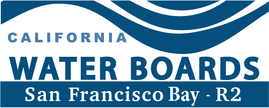
Frequently Asked Questions about the
San Francisco Bay Harmful Algal Bloom
September 8, 2023
In early September, discolored water was reported near Encinal Beach and Sea Plane Lagoon in Alameda. Heterosigma akashiwo, the same species responsible for the previous red tides, was identified in samples. We will continue to work with our partners to monitor the Bay. Discolored water and other signs of potential harmful algae blooms should be reported. Please refer to the FAQ section “What do I do if I see the red tide?” for detailed reporting instructions.
Why is the water in San Francisco Bay reddish brown?
The San Francisco Bay is experiencing a type of harmful algal bloom (HAB) known as a red tide. The species associated with this bloom, Heterosigma akashiwo, can cause water to take on a reddish-brown color. We are continuing to monitor the bloom.
Is this normal?
Red tides are known to occur off the coast of California, usually from early spring through late summer. They can be bioluminescent at night, often looking like glowing waves from the beach. They can last days to months and it is difficult to predict how long they will last due to sunlight, temperature, tidal flow, stratified water columns and nutrients. Red tides can cause depletion of oxygen in the water that marine life needs to survive. It is not as common for red tides to enter the estuarine environment like the one in the San Francisco Bay, however, in summer 2022 a major red tide event associated with the same species, Heterosigma akashiwo, caused significant fish mortality throughout the Bay. In late July 2023, another red tide was observed, but it dissipated by early August.
Is it safe eat the shellfish or swim?
This type of red tide is not known to cause human illness, but we always encourage people and pets to avoid contact with any discolored water that may be caused by the red tide and to practice healthy water habits.
The San Francisco Bay Regional Water Quality Control Board works with various agencies to post caution advisory signs near affected waters (e.g., Crown Beach, Berkeley Marina, and Albany Beach), so the public knows to avoid contact with the discolored water caused by the red tide. We encourage other water-based facilities that observe discolored water to post similar signs to keep the public informed.
The California Department of Public Health (CDPH) manages the Marine Biotoxin Monitoring Program for bivalve shellfish in California. For more information on shellfish health advisories, contact the CDPH marine biotoxin monitoring program or redtide@cdph.ca.gov.
What do I do if I see the red tide?
Suspected HABs, including red tides and potential HAB-related illness or death, should be reported to the Water Boards by filling out the online HAB Report form or by contacting the HAB Hotline: Email: CyanoHAB.Reports@waterboards.ca.gov; Phone: 1-844-729-6466 (toll free). Observations of dead fish should also be reported to the SF Bay Harmful Algae Bloom 2023 project on iNaturalist set up by California Department of Fish and Wildlife for tracking and response.
What are the Water Boards doing about this HAB?
The Water Boards are tracking this red tide, coordinating with agency partners and sharing this information with interested parties.
The Water Boards continue to work closely with San Francisco Estuary Institute and teams of researchers, including the U.S. Geological Survey, to understand the spatial extent of the bloom and what impacts it has on fish and wildlife.
Ongoing field work will track this bloom’s progression, including related water quality impacts; characterize the bloom’s response to biological, geological, and chemical factors; and attempt to identify the factors that contribute most strongly to the bloom’s expansion and its eventual end. Understanding these factors will be increasingly important as the climate changes because warming waters could lead to more frequented tides in the future.
What are the Water Boards doing to address nutrient inputs into San Francisco Bay?
The San Francisco Bay Water Board has an ongoing effort to determine how best to manage nutrient inputs to the Bay. This Nutrient Management Strategy includes collaboration with researchers, dischargers, and other agencies to study potential impacts of nutrients on San Francisco Bay and to evaluate potential management actions to control nutrient inputs to avoid or respond to adverse impacts. The Nutrient Management Strategy is funding the San Francisco Estuary Institute to study what causes HABs and to characterize this specific bloom.
As required by the Nutrients Watershed National Pollutant Discharge Elimination System Permit issued by the San Francisco Bay Regional Water Board in 2019, municipal wastewater treatment plants that discharge into San Francisco Bay collectively contribute $2.2 million dollars per year to fund about 80 percent of the Nutrient Management Strategy budget.
Over the past several years, major investments augmenting our capacity to monitor HABs include the following:
- Systematic collection of algal toxin data during recurring channel cruises
- Development of DNA-sequencing techniques for specific algal species
- Sampling for algal species of concern and their toxins during lateral mapping surveys
- Measurement of algal toxins in bivalves at several locations
Where can I find more information?
- State Water Board HAB Incident Report Map for updates related to this bloom
- Water Boards' satellite tool that displays Sentinel 3 chlorophyll a data to better understand the status and trend of the bloom in the SF Bay
- Office of Environmental Health and Hazard Assessment Interagency Marine Harmful Algal Bloom (HAB)-Related Illness Tracking
- CA Department of Fish and Wildlife Health Advisories and Closures for California Finfish, Shellfish, and Crustaceans
- The CA Department of Public Health Shellfish Program, Marine Biotoxin Monitoring Program, Phytoplankton Monitoring Program, and Toxic Phytoplankton Observations Map
- CA Department of Public Health Red Tides: Questions and Answers



